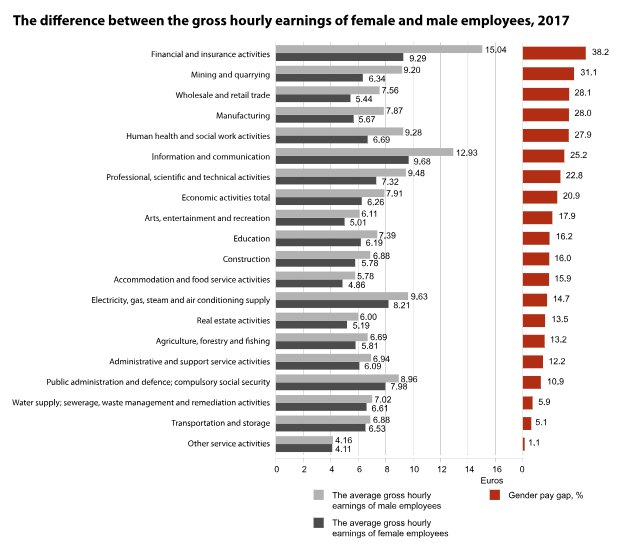Analytics, Estonia, EU – Baltic States, Financial Services, Markets and Companies, Society, Wages
International Internet Magazine. Baltic States news & analytics
Wednesday, 24.04.2024, 03:52
The gender pay gap remained at 21% in Estonia
 Print version
Print versionIn October 2017, the average gross hourly earnings without irregular
bonuses and premiums were 6.26 euros for female employees and 7.91 euros for
male employees. Compared to 2016, gross hourly earnings increased 3.7% for both
female and male employees. While in 2014–2016, the gross hourly earnings of
female employees rose faster than the gross hourly earnings of male employees,
which is the main reason for the decrease in the pay gap (the difference
between the hourly earnings of male and female employees), in 2017, the rise in
the gross hourly earnings was equal.
In 2017, the
gender pay gap was the biggest in financial and insurance activities (38.2%),
where the gross hourly earnings of male employees rose (7.3%) compared to a
year earlier, while the gross hourly earnings of female employees remained
relatively constant (decreased 1.1%).

After financial
and insurance activities, the next biggest pay gaps were recorded in mining and
quarrying (31.1%), wholesale and retail trade (28.1%), manufacturing (28.0%)
and human health and social work activities (27.9%). The difference between the
gross hourly earnings of male and female employees was the smallest in water supply;
sewerage, waste management and remediation activities (5.9%), transportation
and storage (5.1%) and other service activities (1.1%).
Compared to 2016,
the gender pay gap increased the most in financial and insurance activities
(5.2 percentage points), transportation and storage (5.1 percentage points) and
professional, scientific and technical activities (4.2 percentage points) and
decreased the most in other service activities (6.7 percentage points) and in
arts, entertainment and recreation (6.6 percentage points). In the past five
years, the gender pay gap has decreased the most in other service activities
and in education and increased the most in human health and social work
activities.
With regard to
type of ownership, the pay gap in institutions and enterprises owned by the
state and municipalities was smaller than in enterprises owned by Estonian or
foreign private entities. This was the case also in previous years. In 2017,
the pay gap in state institutions and enterprises was 18.4% and in municipal
institutions and enterprises 12.2%, whereas the pay gap in the enterprises
owned by Estonian private entities was 19.2% and in the enterprises owned by
foreign private entities 30.8%.
The pay gap in the
public sector (state and municipal institutions and enterprises) and private
sector (enterprises owned by Estonian and foreign private entities) was almost
the same – 22.4% and 22.0%, respectively.
In 2017, the pay gap was the biggest in Ida-Viru
county (27.9%), followed by Järva (25.6%), Hiiu (25.3%) and Võru (24.0%)
counties and the smallest in Saare (11.3%), Põlva (12.9%), Lääne-Viru (14.3)
and Rapla (15.0%) counties.
Statistics Estonia and Eurostat use different
population to calculate the gender pay gap. Although Eurostat receives data
from the statistical offices of the Member States, the pay gap published by
Eurostat does not take into account the indicators of enterprises and
institutions with fewer than 10 employees; it also excludes the earnings of
employees in agriculture, forestry and fishing and in public administration and
defence. According to Eurostat’s calculations, the gender pay gap in Estonia is
the biggest in the European Union (25.3% in 2016). According to Statistics
Estonia, the gender pay gap in Estonia in 2016 was 20.9%, taking into account
all enterprises and institutions and all economic activities.
Statistics Estonia has calculated the pay gap since
1994. In 2017, the sample included around 12,300 enterprises, institutions
and organisations. The gender pay gap is calculated by deducting the
average gross hourly earnings of female employees from the average gross hourly
earnings of male employees, divided by the average gross hourly earnings of
male employees and expressed as a percentage. The calculated average gross
hourly earnings do not include irregular bonuses and premiums.
The statistics are based on the questionnaire “Gender pay gap” (until 2017,
the name of the statistical activity was “Wages, annex for October”), the
deadline of which was 1 December 2017. For the statistical activity, the main
representative of public interest is the Ministry of Economic Affairs and
Communications, commissioned by whom Statistics Estonia collects and analyses
the data necessary for conducting the statistical activity.








 «The Baltic Course» Is Sold and Stays in Business!
«The Baltic Course» Is Sold and Stays in Business!

